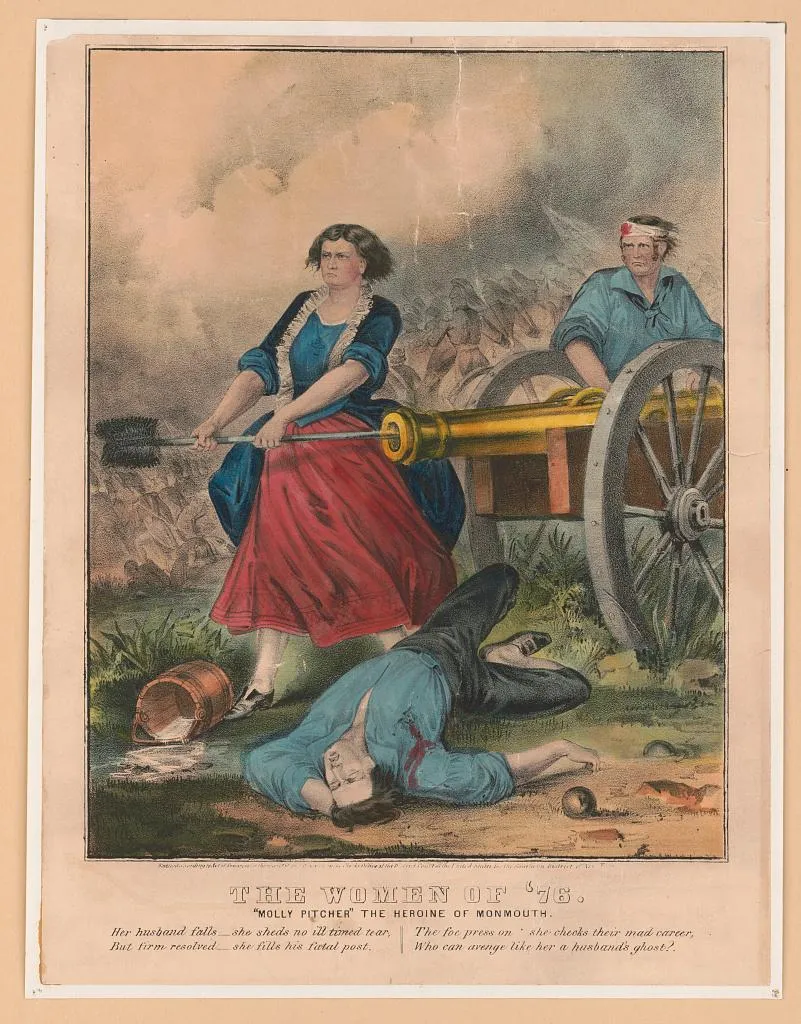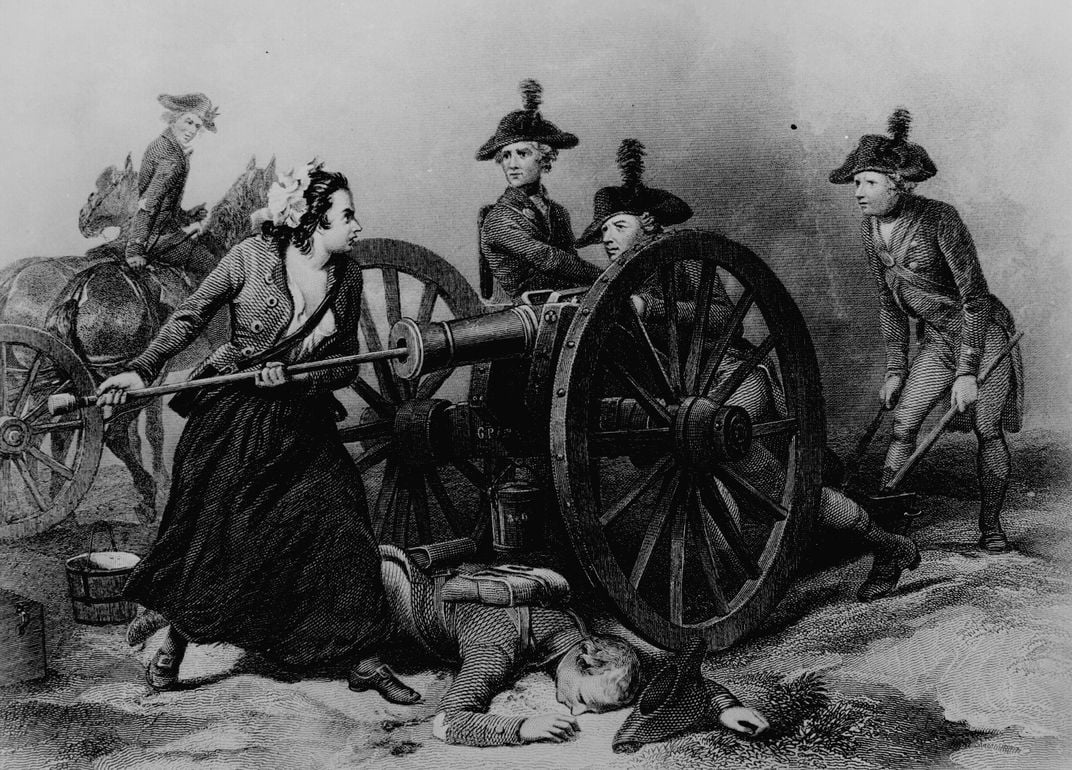Molly Pitcher, the Most Famous American Hero Who Never Existed
Americans don’t need to rely on legends to tell the stories of women in the Revolution
:focal(2834x1225:2835x1226)/https://tf-cmsv2-smithsonianmag-media.s3.amazonaws.com/filer/a3/f8/a3f8668c-54be-4c99-94d5-a565d5241040/gettyimages-51055212.jpg)
In under a day’s time, a traveler in the mid-Atlantic could get breakfast at the Molly Pitcher Waffle Shop in Chambersburg, Pennsylvania, then drive north to see the Molly Pitcher grave and statue in nearby Carlisle and grab a drink at the town’s Molly Pitcher Brewing Company. Drive east for a few hours, and they’d be at the Molly Pitcher memorial at Monmouth Battlefield State Park, the site of her alleged heroic feats. Not far away, before heading back home, the traveler could stop for a snack at the Molly Pitcher Service Area along the New Jersey Turnpike.
At the end of their itinerary, they might have gotten a sense of how Molly Pitcher, the beloved freedom fighter who joined the Battle of Monmouth upon seeing her slain husband, contributed to the American Revolution, but in reality, they were just chasing a figment of the American imagination.
The legend of Molly Pitcher is perhaps best told visually, the way 19th-century Americans captivated by her story would have seen and propagated it. In 1854, artist Dennis Malone Carter created a large canvas with Molly at its center, holding a ramroad beside a cannon that has just been fired, her dead husband lying at her feet. The popular lithographers Currier & Ives likewise sold a print showing a fiercely determined but richly dressed Molly jamming the ramroad into a cannon, similarly accompanied by the fallen husband as well as a pail of water she had dropped.

Any number of books and popular websites will tell you today that while “Molly Pitcher” never existed, the real woman behind the nickname was likely Mary Ludwig Hays McCauley. The National Women’s History Museum, the American Battlefield Trust, the National Archives , the American Revolution Museum at Yorktown, and New York’s Fraunces Tavern Museum all have stories about McCauley, the real-life heroine of the Battle of Monmouth. On June 28, 1778, the popular history goes, McCauley was delivering water to men on the field (hence the “pitcher” nickname) and took over manning her husband’s cannon after he was killed. McCauley was then recognized by George Washington himself as a non-commissioned officer.
The problem is, McCauley’s story itself is also likely the stuff of legend. No account from her lifetime says she was on the battlefront; it was not until after her death that the story of her heroism emerged and that she became associated with the “Molly Pitcher” nickname. But stories about a brave woman at the Battle of Monmouth have been found in the historical record, stories which have been tied to her. Could they be true?
One infamous story that was later interpreted as being about McCauley comes from Revolutionary War veteran Joseph Plumb Martin’s 1830 book, A Narrative of Some of the Adventures, Dangers, and Sufferings of a Revolutionary Soldier. Martin’s description of a woman at Monmouth is quite remarkable:
“A woman whose husband belonged to the artillery and who was then attached to a piece in the engagement, attended with her husband at the piece the whole time. While in the act of reaching a cartridge and having one of her feet as far before the other as she could step, a cannon shot from the enemy passed directly between her legs without doing any other damage than carrying away all the lower part of her petticoat. Looking at it with apparent unconcern, she observed that it was lucky it did not pass a little higher, for in that case it might have carried away something else, and continued her occupation.”
Martin never mentions this woman by name and the story sounds more humorous than true; as one historian surmises, it “may be a variation of a common camp story, perhaps sexual in content.”
Martin wasn’t the only one to regale readers with a woman helping with artillery during the battle. In a 1927 book The Battle of Monmouth, author William Stryker quoted the diary of a surgeon named Albigence Waldo who had heard a similar story from a wounded soldier he treated. The woman had taken up her fallen husband’s gun and “like a Spartan herione” she “fought with astonishing bravery, discharging the piece with as much regularity as any soldier present.” Albigence Waldo (unusual name notwithstanding) was a real army surgeon whose diary from the 1777-1778 winter survives. But this portion of the diary has never been located; did Stryker make it up? Even if that part of the diary did exist at one point, Waldo never mentions the name of this heroic woman.

The legend of a woman taking over her fallen husband’s artillery gained further attention when George Washington’s own adopted son (and Martha’s grandson from her first marriage) George Washington Parke Custis recounted it in an 1840 newspaper article. A woman he called “Captain Molly” was bringing water to men on the field at Monmouth, and after her husband was shot dead, she “threw down the pail of water, and crying to her dead consort, ‘lie there my darling while I avenge ye,’ grasped the ramrod, … sent home the charge, and called to the matrosses to prime and fire.” For her bravery, the next morning George Washington met with her to recognize her service. Yet despite his close relationship with the original commander-in-chief, Custis’ stories about the war were rarely family testimonials and instead legends passed down years later by others.
It’s unclear exactly how these stories became pinned to McCauley, but it happened in the decades after her death in 1832. She applied for a pension from the state of Pennsylvania in 1822 as a widow of a veteran, but when it was awarded, it was “for services rendered” during the war. By the time of her son’s death in 1856, his obituary identified him as “the son of the ever-to-be-remembered heroine, the celebrated ‘Molly Pitcher.’” As part of national celebrations of the centennial of the Revolution in 1876, the Patriot Order of the Sons of America placed a memorial to “Molly Pitcher” at McCauley’s grave in Carlisle.
If the Molly Pitcher/ Mary McCauley story is so flimsy, why do reputable historic sites still tell it? As historian Ray Raphael argues in this 2013 piece deconstructing the legend, “Molly Pitcher needs a flesh-and-blood woman to make her way into the textbooks, where mythic figures are not allowed, and modern textbooks, seeking a female presence, need those dramatic paintings of Molly working her cannon.” While Raphael and other historians have debunked the McCauley tale for years, once a story like this makes its way into a few publications, it gets repeated again and again.
Americans don’t need to rely on legends to tell the stories of women in the Revolution, however. There is much stronger evidence that another woman, Margaret Corbin (whom historians think also contributed to the Molly Pitcher legend) manned a canon at the Battle of Fort Washington in New York and lost the use of her left arm in the process. She was sent to the Corps of Invalids at West Point, where she was known in the records as “Captain Molly,” and became the first woman in American history to receive a lifelong pension for military service.
Perhaps the most remarkable female soldier of the Revolution, however, was a woman named Deborah Sampson who entered the military as a man named Robert Shurtliff in 1782. She served with the Light Infantry Troops in New York and her gender identity was only discovered when she fell ill and was examined by a doctor. After the war, she married, received a military pension, and achieved fame with a speaking tour in which she told her story.
/https://tf-cmsv2-smithsonianmag-media.s3.amazonaws.com/filer/55/d9/55d9eead-4bf8-46fa-aed2-592ab49964e8/gettyimages-3209054.jpg)
Countless more women, whose names we may never know, served at the battlefront as nurses, cooks, laundresses and camp followers. The last group describes women who accompanied the troops and provided domestic (and sometimes sexual) services, in some cases because they were simply too poor to provide for their families with their husbands away fighting. Historian Holly Mayer estimates that perhaps 7,000 women accompanied the American troops during the war. George Washington complained in 1777 that “the multitude of women in particular…are a clog upon every movement.” But he knew that the soldiers would desert without them, and that their labor was necessary. Some of these women later applied for pensions, and more research is needed in the voluminous pension files of the National Archives to flesh out these stories.
The next time you pass Molly Pitcher Service Area as you drive on the New Jersey Turnpike, or see her image in a textbook, spare a thought for the real female heroes of the American Revolution. We may not know many of their names, but thousands of them helped America achieve its independence.
Learn more about women’s roles and power in this era with Cassandra Good’s new Audible Original from The Great Courses, America’s Founding Women.
